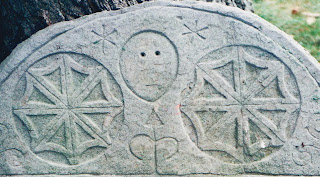
(Eighteenth century sandstone marker from the Ancient Burying Ground, Wethersfield, Connecticut)
I recently had a conversation with a twenty something painter I know who seems rather enamored of the idea of revisionist history. I was attempting to explain that my interest in historical gravestone carving is centered around what I perceive to be a common human need to create visual works of art which grapple with the subject of mortality and death. He was pretty much interested in beating up on dead white guys and dismissing colonial gravestones as New England kitsch.
.......so, since I am neither protestant nor of English decent, but am profoundly moved by what I see as the universal symbolism and imagery found on seventeenth and eighteenth century carved markers, I thought I'd play a little devil's advocate this week.
(This is a small carving from Hampton, CT. It was done by a carver who was given the rather un PC title "The Hampton Indian Carver" back in the twentieth century.)
("feathered" effigy from New Salem, MA)
(A "Pre-Columbian" look from Hartford, CT)
Obviously the colonial era gravestones in question were created by white protestants (mostly English, some Dutch) and, even more specifically, the vast majority of New England stones were created by the now demonized Puritans. Certainly the earliest slate markers in the Massachusetts Bay Colony - familial coats of arms, memento mori tableau - were based on European references, but as colonization progressed the craft developed a vocabulary of it's own, centering around the humanoid "soul effigy". Soul effigies range from crude and primitive to complex and flamboyant. They were often carved by unsophisticated rural artisans living in a frontier environment......and not everyone living in the colonies was white. Of course, the people who carved the stones were white and the few extant monuments to slaves, servants or other African Americans from the period appear to have been created by the same carvers who created the stones for the members of the white community. I have come across some theoretical references to the possibility of African American apprentices in stone carving shops, but no specific proof. I have also read theories regarding the possibility of Native American influences on designs (Harriett Marrifield Forbes in her 1927 book Gravestones of Early New England and the Men Who Made Them), but again, unless I have missed some new emerging data (entirely possible, so please correct me if I'm wrong), there is no proof of this either - only speculation based on stylistic motifs.
(Three more effigies: Brooklyn, CT 1788, Rowley, MA 1705 and Ipswhich, MA)


I am reminded of folks like Erich Von Daniken who develop complex theories about human history and pre history based on visual similarities between works created by artists in widely divergent periods and cultures. In other words, if a prehistoric rock carving in Australia looks like a spaceman, then it must be a spaceman!
I am not a theorist. Some early American stone carvings absolutely resemble African masks. Some soul effigies appear to be wearing feathered head dresses (likely stylized variations on wings). Still others seem to refer back to Celtic or Roman era (a subject for another time) faces. Any or all of these influences are possible. Equally possible is the idea that icons are icons and that variations on the human face transcend culture and time.
Today I'm offering a few examples for you to consider.......
(Headstones South Glastonbury, CT and Bronx, NY)
(Border designs: Simsbury, CT and Haverhill, MA)
Some examples of more elaborate, but not traditionally "western" effigy variations, all from central Connecticut.
Some "primitive masks" from Haverhill, Harvard and Lexington, MA.
...and Paganism manifests itself in the form of an earth goddess with vegetation sprouting form her head....a preview of my next entry!















HI there Alison,
ReplyDeleteI love you blog! What an awesome collection of photos!
I was wondering if you could answer a question about a footstone motif i saw in the Greenfield hill cemetary in CT. It has what appear to be plant shoots, tadpoles, or primitively drawn lilies on a field of stripes. I saw it about 5 or 6 times throughout the cemetery and I was wondering if it is some sort of mortality symbol that I don't recognize.
I am including (as my profile picture) a pair of glass paintings I did using this motif turned on its side. Sorry, I don't have a picture because I didn't have my camera the day I was at the graveyard. If the photo of the paintings is hard to make out, I can scan my original sketch later!
Again, I love your blog -- it is great to see the huge spectrum of soul effigies/death heads all in one place. It is so moving to me that overwhelmingly carvers articulated so much natural and metaphysical imagery rather than relying on religious iconography. Much more universal! Your posts make me want to read Daniken!
Abby-first, welcome and so glad you've found my site! Your glass images are lovely and I have seen this image before-my memory is that I've seen it on a footstone, so maybe some annotated version of a more complex design that might have been on a matching headstone. I'll see if I can't find out a little more and get back to you.
ReplyDeletebest, AP